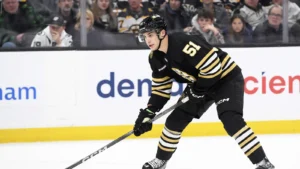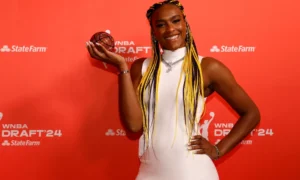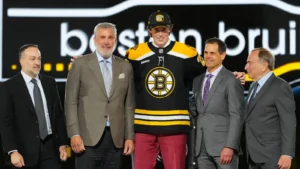
Brad Treliving is in the midst of his first trade deadline as the Toronto Maple Leafs General Manager. As one of the most exciting days on the NHL calendar, it has evolved into a month-long event that many fans anticipate as their favorite team attempts to either strengthen for the playoffs or sell assets as part of a rebuild.
Before Treliving came over as General Manager, the Maple Leafs had four different General Managers handle trade deadlines during the previous 15 years. Here are their finest and worst performances around the career-defining day.
Kyle Dubas served as the Leafs’ general manager from 2018 until 2023.
Worst deadline: 2021
Key acquisitions: Nick Foligno, Riley Nash, David Rittich, Ben Hutton, Stefan Noesen.
Alexander Barabanov lost one first-round pick (2021), one third-round pick (2022), two fourth-round picks (2021 and 2022), one fifth-round pick (2022), and one sixth-round pick (2022).
Kyle Dubas surrendered nearly an entire draft class’s worth of assets in April 2021, giving up six total picks, including that year’s first rounder, for a handful of depth players led by Columbus Blue Jackets captain Nick Foligno.
None of the acquisitions had any notable impact on the Maple Leafs, with all four players combining for 12 regular season games and four points. That figure is made worse by the fact that Alexander Barabanov went on to score 7 points in 9 games that season, virtually doubling the aggregate productivity of every single player Toronto acquired.
Despite the steep price paid at the deadline, the Maple Leafs lost in the first round, with only six total playoff games and a single point from all five acquired players. A year later, every single one of those acquisitions had moved on to another team, and Kyle Dubas had nothing to show for it, whereas Barabanov remained with the Sharks, scoring more than 45 points each of the next two seasons.
Best Deadline: 2023
Key acquisitions: Ryan O’Rielly, Noel Acciari, Jake McCabe, Luke Schenn, Sam Lafferty, Erik Gustaffson, Radim Zohorna. One first round pick (2023), one third round pick (2024), and two fifth round picks (2024, 2025).
Key losses include Rasmus Sandin, Pierre Engvall, and Dryden Hunt. Two first-round picks (2023, 2025), two second-round picks (2024, 2026), two third-round picks (2023, 2023), one fourth-round pick (2025).
Kyle Dubas found the trade deadline fascinating since it felt more like a retool than a full buying deadline. It is unusual for a competitive team to obtain a first round pick at the deadline, but that is exactly what happened when Dubas traded Rasmus Sandin for a first round choice to make room on the blueline and salary cap for the new acquisitions.
After years of supporters complaining that the team needed more size and toughness, the organization went out and got it, signing Ryan O’Rielly, Jake McCabe, and Luke Schenn to bolster their ability to hit and grind out opponents while cementing defensive responsibility in the back end and down the middle.
The measures would pay off in part, as Toronto advanced beyond the first round for the first time in nearly two decades. Jake McCabe would remain on the squad, playing an important role on defense, while the Leafs used the acquired first-round pick to draft Easton Cowan, who has since evolved into one of the OHL’s top players and the Maple Leafs’ top prospect.
Lou Lamoriello served as the Leafs’ general manager from 2015-2018.
The worst deadline is 2018
Key acquisitions: Tomas Plekanec, one fourth-round pick (2019), and one seventh-round pick (2020).
Key Losses: Eric Fehr, Nikita Soshnikov, and one second-round pick (2018).
Lou Lamoriello, unlike Kyle Dubas, made few moves at the trade deadline. In his credit, the Leafs weren’t yet contenders at the time, so trading key players for a playoff push didn’t seem like a good idea.
Even so, the 2018 trade deadline is unusual. The team was on the rise and searching for some seasoned assistance to give a group of bright rookies a boost. The major acquisition? Tomas Plekanec. Plekanec was in no way a negative force for Toronto. Despite only two assists during the regular season, he was a surprising contributor in the playoffs on both sides of the rink. However, the move appeared to be made only for the purpose of making moves, and given that Toronto took Boston to seven games in that series, fans wondered if the Leafs could have had a deep run and avoided the postseason chokers tag if Lamoriello had made a larger impact.
The best deadline is 2016
Key acquisitions: Colin Greening, Milan Michalek, Jared Cowen, Tobias Lindberg, Daniel Winnick, Ben Smith, Alex Stalock, Raffi Torres. Key losses include Dion Phaneuf, Matt Frattin, Shawn Matthias, Roman Polak, Nick Spaling, James Reimer, Daniel Winnick, and one fifth-round pick in 2016.
Despite gaining four second-round picks, the true triumph of Lou Lamoriello’s 2016 trade deadline was making Toronto awful enough to finish last and win the Auston Matthews lottery.
The month began with a bang, with Toronto transferring captain Dion Phaneuf to provincial rival Ottawa, and the fire sale only continued, with contributing forwards, defencemen, and even the starting goalkeeper all leaving to assure the team finished last place. It was a terrific manner for Lou to handle his first trade deadline as Toronto’s General Manager, and the team is still reaping the benefits today.
Dave Nonis served as Leafs GM from 2013-2015.
The worst deadline is 2014
Key acquisitions: None.
No significant losses have occurred.
It’s unclear whether Dave Nonis was on vacation in the month preceding up to March 5, 2014, but he certainly looked to act like it. The Toronto Maple Leafs made no trades in the weeks preceding up to the 2014 trade deadline, with the sole notable transaction of the season being the acquisition of Tim Gleason for John Michael-Liles on January 1st.
With the team making a surprise playoff appearance the previous season, nearly defeating the Boston Bruins in Game 7 before the infamous collapse, the Maple Leafs appeared to be unsure whether they were a piece away from being contenders, or just pretenders who got lucky in a lockout-shortened season. As a result, they are standing pat and allowing the NHL to evolve around them.
Best Deadline: 2015
Key acquisitions: Nathan Horton, Brendan Leipsic, Joakim Lindstron, Eric Brewer, TJ Brennan, Zach Sill. 1 First Round Pick (2015), 1 Second Round Pick (2016), 1 Fourth Round Pick (2015), 1 Fifth Round Pick (2015), and 1 Sixth Round Pick (2016).
Key Losses: David Clarkson, Cody Franson, Mike Santorelli, Daniel Winnik, Spencer Abbott, and Koribian Holzer
Despite gaining five total draft picks, including a first and a second for primarily spare parts, the Leafs’ biggest move of the deadline was the release of David Clarkson’s contract with no salary retention. Nonis appeared to be on cleanup duty, allowing other teams to use Toronto’s wealth as a dumping ground for bad contracts, picking up the uninsured Nathan Horton deal and putting him on LTIR, as well as acquiring Eric Brewer and Olli Jokinen (who was later traded for a late draft pick) from teams looking to clear roster space.
Unfortunately for Nonis, despite his outstanding achievement at the 2015 deadline, he was fired just over a month later and replaced by Lou Lamoriello.
Brian Burke served as the Leafs’ GM from 2008 to 2013.
The worst deadline is 2012
Mark Fraser and Carter Ashton are among the key acquisitions.
Dale Mitchell and Keith Aulie are among the key losses.
The worst thing that a sports team can do is remain in limbo. The Toronto Maple Leafs looked just like this in 2012, hovering in the center without a clear direction as to whether they were buying or selling.
The only two trades made around the deadline were insignificant ones, Fraser for Mitchell and Ashton for Aulie. It’s no wonder that Burke was removed of his duties less than a year later, as he, too, was unsure about the Maple Leafs’ identity.
The best deadline is 2011
Key acquisitions: Joffrey Lupul, Jake Gardiner, Aaron Voros. Two first-round picks (2011), one second-round pick (2012), one third-round pick (2011), one fourth-round pick (2014), and one seventh-round pick (2012).
Key Losses: Tomas Kaberle, Kris Versteeg, Francois Beauchemin, John Mitchell.
A year may make a huge difference. While the Leafs were directionless in 2012, they were unambiguous sellers at the deadline, with Brian Burke earning a king’s ransom in the month preceding up to the deadline. Burke not only acquired several first-round picks in exchange for Tomas Kaberle and Kris Versteeg, but he also got Joffrey Lupul and Jake Gardiner in a deal that sent Francois Beauchemin to Anaheim.
Lupul and Gardiner would go on to become top-line players for the Maple Leafs over the next few years, as the team appeared to be embracing a rebuilding process.







